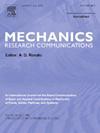Investigation of static and dynamic responses of tensegrity-based footbridge structures with integrated deck plates subjected to time-independent load
IF 2.3
4区 工程技术
Q3 MECHANICS
引用次数: 0
Abstract
The tensegrity system’s nonlinear static and dynamic response has been used to describe the structural behavior of the tensegrity-based footbridge. However, the results may lead to inaccurate structural behavior because the structural model in studies of tensegrity bridges does not account for the deck. Therefore, the main objective of this study is to evaluate two models, one consisting of pure tensegrity components currently used as the footbridge model and a proposed model consisting of an integrated tensegrity and deck plate system. For this purpose, the finite element approach, alongside the Reissner–Mindlin theory for nonlinear deformation of discrete deck plate elements, is used to establish the nonlinear static and dynamic equations based on system equilibrium, which are linearized and solved to gain insight into the sensitivity of the structural element to variations in the initial prestress. The results show that including the deck plate significantly enhances predictive accuracy for the nonlinear behavior of the tensegrity-based footbridge. In contrast, the models without the deck plate exhibit substantial structural inaccuracies under varying initial prestress conditions. This research highlights the crucial role of initial prestressing and the deck plate’s integration in optimizing the structural performance of tensegrity-based footbridge systems.
基于张拉体的集成桥面人行桥结构在时无关荷载作用下的静动力响应研究
采用张拉整体系统的非线性静动力响应来描述人行桥的结构性能。然而,研究结果可能导致不准确的结构性能,因为在研究张拉整体桥梁的结构模型没有考虑甲板。因此,本研究的主要目的是评估两种模型,一种是由目前用作人行桥模型的纯张拉整体组件组成的模型,另一种是由张拉整体和桥面板系统组成的拟议模型。为此,采用有限元方法,结合离散甲板板单元非线性变形的Reissner-Mindlin理论,建立了基于系统平衡的非线性静力和动力方程,并对其进行线性化和求解,以了解结构单元对初始预应力变化的敏感性。结果表明,将桥面板纳入模型可显著提高对张拉整体人行桥非线性行为的预测精度。相比之下,没有甲板板的模型在不同的初始预应力条件下表现出实质性的结构不准确性。本研究强调了初始预应力和桥面板集成在优化张拉整体人行桥体系结构性能中的关键作用。
本文章由计算机程序翻译,如有差异,请以英文原文为准。
求助全文
约1分钟内获得全文
求助全文
来源期刊
CiteScore
4.10
自引率
4.20%
发文量
114
审稿时长
9 months
期刊介绍:
Mechanics Research Communications publishes, as rapidly as possible, peer-reviewed manuscripts of high standards but restricted length. It aims to provide:
• a fast means of communication
• an exchange of ideas among workers in mechanics
• an effective method of bringing new results quickly to the public
• an informal vehicle for the discussion
• of ideas that may still be in the formative stages
The field of Mechanics will be understood to encompass the behavior of continua, fluids, solids, particles and their mixtures. Submissions must contain a strong, novel contribution to the field of mechanics, and ideally should be focused on current issues in the field involving theoretical, experimental and/or applied research, preferably within the broad expertise encompassed by the Board of Associate Editors. Deviations from these areas should be discussed in advance with the Editor-in-Chief.

 求助内容:
求助内容: 应助结果提醒方式:
应助结果提醒方式:


